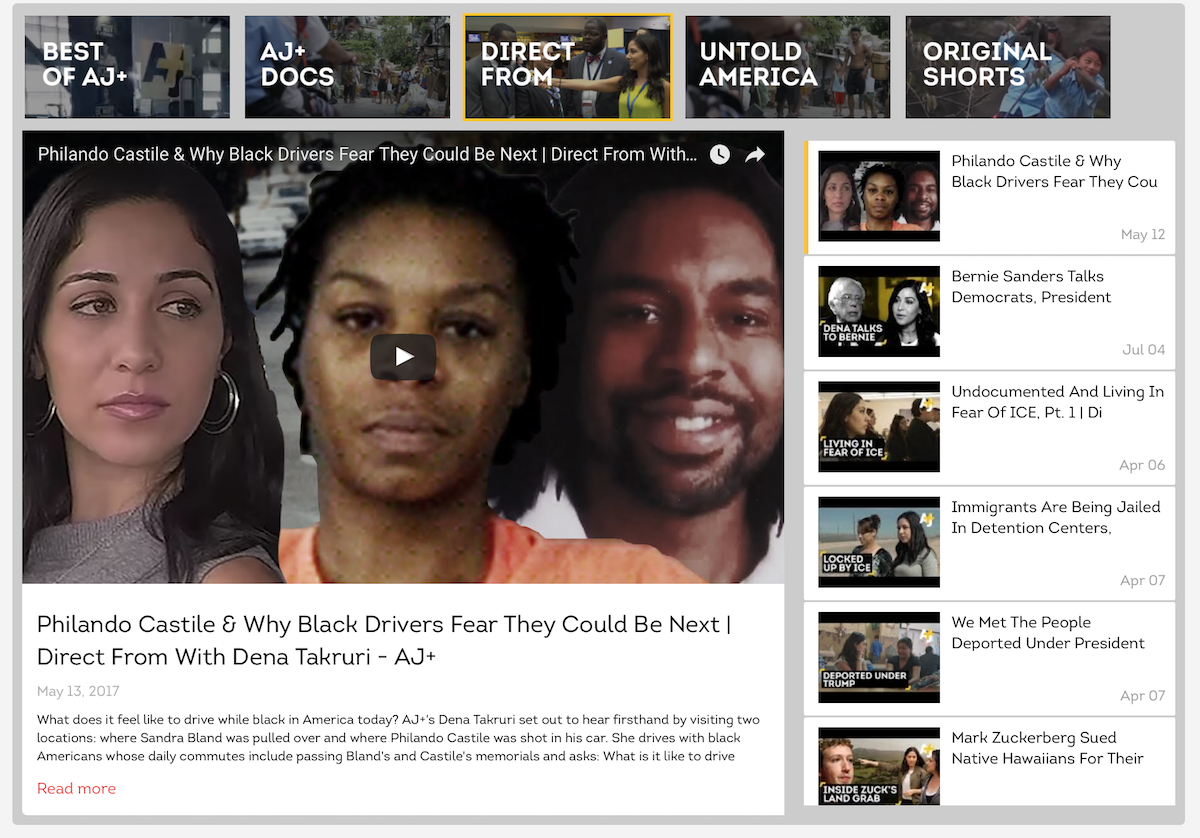[Congress speaker Q&A] How video and social are perfect partner for news

Tell us why you chose video and digital particularly and how you found your way there…
My childhood friends still remember me using a round hairbrush as a microphone to interview them. I think many of us have stories like that. For the immigrants among us, I find many have similar reasons for wanting to tell stories – our representation was (and still is) lacking and the stories told about us were most often faulty narratives. I started out at my high school paper, then college. I always thought I’d be a print journalist. But I graduated journalism school at a time when the newspaper industry in the U.S. was in crisis. I arrived at The New York Times for an internship to see editors taking buy-outs. Craigslist was being blamed for the newspaper industry’s sharp decline by luring billions in classified revenue away. My first placement at the NYT was at its Continuous News Desk, which was one of the first 24-hour online news desks in the country. Our job was to collect reporting from the journalists we had stationed around the world and write short, breaking web versions of the longer stories they were working on. I didn’t know then that work would prepare me for what I’d be doing almost 10 years later.
 |
Shadi Rahimi, video producer at AJ+
After working at a few other newspapers, I left journalism because I couldn’t afford to live in San Francisco on a reporter’s salary. I took a job as a communications director for a juvenile justice nonprofit. (Yes, nonprofits paid more than journalism then). Nearly three years later, the so-called Arab Spring happened. A Bay Area activist living in Egypt invited anyone interested in visiting to come stay with her. That May I took her up on the offer. I’d never before visited a place in such an anarchist, calm before the storm, state. I met people I wanted to live among. I quit my job, sold my belongings, bought a camera and moved to Egypt. I had no plan other than to live (everywhere) overseas and return to reporting. My lack of Arabic meant I was mostly taking photographs at first. But when the police resumed killing people in the streets, I began filming, following a group of young boys (soccer fans called “Ultras”) who represented the first line of defense for protestors, directly facing off with police in bloody battles. While working on a self-funded documentary about them, I freelanced, worked the night shift copy-editing for an Egyptian newspaper, and for a short while managed an online documentary project for fellow U.C. Berkeley Graduate School of Journalism alumnus, Jigar Mehta. A few years later he would be hiring for Al Jazeera’s new digital channel, AJ+. That’s how I ended up back in San Francisco.
Egypt was where I first saw the power of digital media in action. It was where I first saw non-journalists using mobile phones to report the news by broadcasting directly and in real time on Twitter and Facebook to the masses, completely bypassing legacy media. I would later see these tools and methods used in the same manner in the U.S., during the protests in Ferguson, MO, over the killing of unarmed black teen Michael Brown by a white police officer Darren Wilson. Egypt was also where I personally embraced visual storytelling as a means to communicate without words. It sounds obvious, but until then I was very married to the written word as my medium. Egypt changed everything. And it was where I witnessed for the first time the efficacy of (citizen) video to inform and even change hearts and minds when the structural narrative (state media) was reporting the opposite. Those were all lessons I carried with me to AJ+.

***Shadi will speak at the 41st FIPP World Congress about how AJ+ engages audiences with video made for social. The Congress takes place from 9-11 October in London. You can book your tickes here***
In 2015 you became one of the first journalists to use Facebook Live to broadcast – and did so in Europe reporting on the refugee crisis and in Palestine amid clashes. Can you share a bit about that – what drove you to do it, what did you hope to achieve, how successful was it?
Just before we left to report on the refugee crisis in Europe, Facebook had begun offering this new feature to go live. At the time it was being offered to verified individual accounts of select media professionals and celebrities. We used the account of Jigar Mehta to broadcast our first reports and then later did on AJ+’s Facebook page. Our entire Europe trip was driven by a mission to humanise the masses spilling across Europe’s borders. Watching from the U.S., you couldn’t get a sense of who the people called refugees were. The reporting was very crisis-based, focused on the macro issues. We wanted to know who the people were and we wanted to share their personal stories with our American millennial audience. Our goal was to journey alongside the people, rather than using the crowds as a backdrop for standups, to show how their journeys could be that of anyone in our audience, if the wrong circumstances arose.
To that end, we broadcast live all along the journey, while walking with refugees from a train station in Hungary across the border into Austria, and from Austria to the border with Germany. Dena speaks Arabic and I speak Farsi, so between the two of us were able to translate the stories of Afghan, Syrian, Iraqi and Palestinian refugees live for our audience. We were essentially a conduit for live conversation between our audience and people they would never otherwise get to speak to. It was a truly transformative experience. It’s hard to measure success when it comes to how you may have changed people’s hearts and minds. But anecdotally I know that there were audience members, including our own staff, who were transfixed during those live dispatches. We returned to Europe this year to catch up with one of the refugees we journeyed with to Germany, Mohammed, and there are audience members who commented that they’d been waiting (nearly two years) to hear what happened to him. One commenter said she had used his story to teach her class about the refugee crisis. Here’s the power of digital media: He commented back to her, connecting in a way that before Facebook was not possible.
You’re the lead producer of AJ+’s Deployment Unit, a roving field team you established at Al Jazeera’s digital-only channel – tell us about that and what the role entails…
AJ+ was created as a semi-autonomous and editorially distinct digital project of Al Jazeera, with a San Francisco-based newsroom tasked with producing video packages with content either found online or commissioned. We didn’t even have access to Al Jazeera’s archives or field teams. We were to distinguish ourselves from anything else Al Jazeera was doing, including field reporting. But then Ferguson happened. And there was just no way we wouldn’t send our own staff to report one of the biggest stories of the year in America. Reporting from Ferguson opened the door for me to try pitching for us to report more from the field. After the viral success of producing several stories in the field with Correspondent Dena Takruri and our cameraman Dariel Medina, I began pushing hard for us to be an actual field-reporting unit. We soon became the sole team sent to report on breaking news of international relevance, from the refugee crisis in Europe to clashes in Palestine. This year, we’ve begun focusing on producing longer, series content for YouTube. Our series is “Direct From With Dena Takruri,” which has thus far taken us to Hawaii to report on indigenous land issues, to Mexico to report on deportations, to Greece and Germany to follow up on the refugee crisis and next to South Korea to report on growing tensions with North Korea. As the senior producer it’s my job to research and pitch stories, and lead all the production efforts. We’ve recently added a producer and associate producer to the team, which is immensely helpful. But we’re still too small and under-resourced to be able to produce the frequency of content that YouTube requires.
You lead the production of videos that most often receive top retention and viewer completion rates on YouTube and earn millions of views on Facebook. So what are your tips for creating winning social videos? – Optimum length, style, ingredients…
For Facebook, grab the audience’s attention with the first three seconds because of autoplay. Otherwise, they’ll keep scrolling. Keep it short, both in video length and wording. Having a short and engaging Facebook post is key. Square Facebook videos are optimised for mobile viewing. Thumbnails matter, the more bright, clear, engaging, eye-catching – the better. Many organisations including ours are now placing large text headlines for the story across the top and bottom of the thumbnail, which may not be pretty but tend to draw even more views. But ultimately if your goal is the highest form of social engagement, shares, as a news organisation your content needs to be solid. Facebook is reportedly encouraging through its algorithm longer pieces, and I’ve seen some with really strong long content do well. But there has to be a good reason for the length. The story must call for it. For YouTube, personality is key, along with a repeatable format that is published on schedule. YouTube viewers view longer pieces.
What platforms lend themselves particularly well to the news genre? I read that you’re an advocate of #mojo, using phones to record, live broadcasting etc.
For breaking news, nothing beats Twitter. For live broadcast using mobile phones, I prefer Facebook for the broader audience and shareability over YouTube, but simultaneous broadcasts on both platforms are great.
Where do you think the video and social relationship goes from here?
I only see more publishers getting into the video game. There’s an oversaturation of the market currently, and I think that’ll continue to increase. Many job listings in media nowadays call for people versed in digital media and social videos. But more than ever I’m also seeing listings for people who are one-person-bands, producer-shooter-editors. It’s an unfortunate trend because it signals that media companies are still lacking, or are unwilling to invest, the money and resources it takes to produce video content. There’s individuals out there who can do it all, but it’s unlikely they’re getting paid the equivalent of the three jobs they’re actually doing. Video is costly. Whether you’re paying for user-generated or commissioned content, or sending teams out there. But it can make a lot of money too, through sponsored content and ads. The lines between advertising and news are becoming more blurred than ever through social media posts that don’t signal the delineation the way a website might. It’ll be interesting to see where we go from here. I think we’re evolving at a faster pace than anyone might have imagined.
***Shadi will speak at the 41st FIPP World Congress about how AJ+ engages audiences with video made for social. The Congress takes place from 9-11 October in London. You can book your tickes here***
More like this
[Congress speaker Q&A] Prisma Media transformation chief: ‘Nothing will ever be the same again’
[Congress speaker Q&A] Inside The Business of Fashion
[Congress speaker Q&A] Still plenty of opportunity in digital advertising – Flipboard exec
[Congress speaker Q&A] How Ebner Media targets special interest audiences with effective advertising
[Congress speaker Q&A] How a Canadian publisher turned ‘the traditional ad model on its head’








